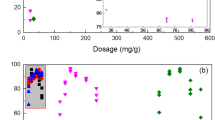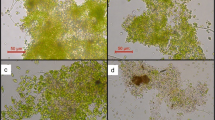Abstract
This study investigated the growth-dependent role of algal organic matters (AOMs) to achieve high removal efficiency (R.E) of microalgae. The results showed that the microalgae cells produced 96 ± 2% of total AOMs as loose bound AOMSS (LB-AOMs) and 4 ± 1% as cell-bound (CB-AOMs) in exponential phase. In stationary phase, LB-AOMs and CB-AOMs were 46 ± 0.7percentage and 54 ± 0.2 percentage, respectively. The R.Es in exponential and stationary phase were 83 ± 2.6% and 66 ± 1.2%, respectively. It is found that the difference of biomass concentration (between exponential and stationary phase) had no significant impact on the R.E (P > 0.01). Further investigations revealed that LB-AOMs inhibit flocculation in exponential and CB-AOMs in stationary phase; however, CB-AOMs showed stronger inhibition than the LB-AOMs (P < 0.01). The provision of calcium (17 ± 0.9 mg/L) to the culture reduced the AOMs inhibition and improved the R.E from 66 ± 1.2% (in control) to 90 ± 4.2%. An increase in R.E was attributed to the interaction of calcium with AOMs and subsequently acting as a flocculant. The findings of this study can be valuable to improve the performance of auto-flocculation technology, which is mainly limited by the presence of AOMs.

Graphical Abstract







Similar content being viewed by others
References
Aboubaraka AE, Aboelfetoh EF, Ebeid E-ZM (2017) Coagulation effectiveness of graphene oxide for the removal of turbidity from raw surface water. Chemosphere 181:738–746
Amavizca E, Bashan Y, Ryu C-M, Farag MA, Bebout BM, de-Bashan LE (2017): Enhanced performance of the microalga Chlorella sorokiniana remotely induced by the plant growth-promoting bacteria Azospirillum brasilense and Bacillus pumilus. Sci Rep 7, 41310
Amit GUK (2018) An approach for phycoremediation of different wastewaters and biodiesel production using microalgae. Environ Sci Pollut Res 25:18673–18681
Atiku H, Mohamed R, Al-Gheethi AA, Wurochekke AA, Kassim AHM (2016) Harvesting of microalgae biomass from the phycoremediation process of greywater. Environ Sci Pollut Res 23:24624–24641
Beuckels A (2013) Influence of organic matter on flocculation of Chlorella vulgaris by calcium phosphate precipitation. Biomass Bioenergy 54:107–114
Borba CE, Guirardello R, Silva EA, Veit MT, Tavares CRG (2006) Removal of nickel(II) ions from aqueous solution by biosorption in a fixed bed column: experimental and theoretical breakthrough curves. Biochem Eng J 30:184–191
Brady PV, Pohl PI, Hewson JC (2014) A coordination chemistry model of algal autoflocculation. Algal Res 5:226–230
Chen J, Leng L, Ye C, Lu Q, Addy M, Wang J, Liu J, Chen P, Ruan R, Zhou W (2018) A comparative study between fungal pellet- and spore-assisted microalgae harvesting methods for algae bioflocculation. Bioresour Technol 259:181–190
Chen W, Gao X, Xu H, Cai Y, Cui J (2017) Influence of extracellular polymeric substances (EPS) treated by combined ultrasound pretreatment and chemical re-flocculation on water treatment sludge settling performance. Chemosphere 170:196–206
Cheng Y-S, Zheng Y, Labavitch JM, VanderGheynst JS (2011) The impact of cell wall carbohydrate composition on the chitosan flocculation of Chlorella. Process Biochem 46:1927–1933
Choi J, Kinney KA, Katz LE (2016) Effect of CaCO3(S)nucleation modes on algae removal from alkaline water. Environmental Science & Technology, XXXXXXXXXX-XXX. https://doi.org/10.1021/acs.est.5b05255
Ding G, Li X, Lin W, Kimochi Y, Sudo R (2017) Enhanced flocculation of two bioflocculation-producing bacteria by secretion of Philodina erythrophthalma. Water Res 112:208–216
Gejji V, Fernando SD (2018) Harvesting microalgae using ionic polyelectrolytes in an aqueous-organic two-phase system: screening of separation parameters using model algal particles. Process Biochem 72:188–197
Huang Z, Wang Y, Jiang L, Xu B, Wang Y, Zhao H, Zhou W (2018) Mechanism and performance of a self-flocculating marine bacterium in saline wastewater treatment. Chem Eng J 334:732–740
Jiménez S, Micó MM, Arnaldos M, Ferrero E, Malfeito JJ, Medina F, Contreras S (2017) Integrated processes for produced water polishing: enhanced flotation/sedimentation combined with advanced oxidation processes. Chemosphere 168:309–317
Kim D-Y, Lee K, Lee J, Lee Y-H, Han J-I, Park J-Y, Oh Y-K (2017) Acidified-flocculation process for harvesting of microalgae: coagulant reutilization and metal-free-microalgae recovery. Bioresour Technol 239:190–196
Lai Y, Zhou Y, Martarella R, Wang Z, Rittmann BE (2016) Synergistic integration of C12 to C16 cationic surfactants for flocculation and lipid extraction from Chlorella biomass. ACS Sustain Chem Eng:752–757
Lee H, Nam K, Yang J-W, Han J-I, Chang Y (2016) Synergistic interaction between metal ions in the sea salts and the extracellular polymeric substances for efficient microalgal harvesting. Algal Res 14:79–82
Liu C, Wang K, Jiang J-H, Liu W-J, Wang J-Y (2015) A novel bioflocculant produced by a salt-tolerant, alkaliphilic and biofilm-forming strain Bacillus agaradhaerens C9 and its application in harvesting Chlorella minutissima UTEX2341. Biochem Eng J 93:166–172
Liu L, Chen J, Lim P-E, Wei D (2018) Dual-species cultivation of microalgae and yeast for enhanced biomass and microbial lipid production. J Appl Phycol 30:2997–3007
Liu Z, Liu Y (2016) Synergistic integration of electrocoagulation and algal cultivation to treat liquid anaerobic digestion effluent and accumulate algal biomass. Process Biochem 51:89–94
Lopez-Exposito P, Campano C, van de Ven TGM, Negro C, Blanco A (2019a) Microalgae harvesting with the novel flocculant hairy cationic nanocrystalline cellulose. Colloids Surf B: Biointerfaces 178:329–336
Lopez-Exposito P, Negro C, Blanco A (2019b) Direct estimation of microalgal flocs fractal dimension through laser reflectance and machine learning. Algal Res 37:240–247
Luo S, Wu X, Jiang H, Yu M, Liu Y, Min A, Li W, Ruan R (2019) Edible fungi-assisted harvesting system for efficient microalgae bio-flocculation. Bioresour Technol 282:325–330
Lv J, Guo J, Feng J, Liu Q, Xie S (2017) Effect of sulfate ions on growth and pollutants removal of self-flocculating microalga Chlorococcum sp. GD in synthetic municipal wastewater. Bioresour Technol 234:289–296
More TT, Yadav JSS, Yan S, Tyagi RD, Surampalli RY (2014) Extracellular polymeric substances of bacteria and their potential environmental applications. J Environ Manag 144:1–25
Okaiyeto K, Nwodo U, Mabinya L, Okoh A (2015) Bacillus toyonensis strain AEMREG6, a bacterium isolated from South African marine environment sediment samples produces a glycoprotein bioflocculant. Molecules 20:5239–5259
Oliveira GA, Carissimi E, Monje-Ramírez I, Velasquez-Orta SB, Rodrigues RT, Ledesma MTO (2018) Comparison between coagulation-flocculation and ozone-flotation for Scenedesmus microalgal biomolecule recovery and nutrient removal from wastewater in a high-rate algal pond. Bioresour Technol 259:334–342
Onyshchenko E, Blandin G, Comas J, Dvoretsky A (2018) Influence of microalgae wastewater treatment culturing conditions on forward osmosis concentration process. Environ Sci Pollut Res:1–12
Phasey J, Vandamme D, Fallowfield HJ (2017b) Harvesting of algae in municipal wastewater treatment by calcium phosphate precipitation mediated by photosynthesis, sodium hydroxide and lime. Algal Res 27:115–120
Pivokonsky M, Safarikova J, Baresova M, Pivokonska L, Kopecka I (2014) A comparison of the character of algal extracellular versus cellular organic matter produced by cyanobacterium, diatom and green alga. Water Res 51:37–46
Pradhan D, Sukla LB, Mishra BB, Devi N (2019) Biosorption for removal of hexavalent chromium using microalgae Scenedesmus sp. Journal of Cleaner Production 209:617–629
Rashid N, Rehman MSU, Han J-I (2013a) Recycling and reuse of spent microalgal biomass for sustainable biofuels. Biochem Eng J 75:101–107
Rashid N, Rehman SU, Han J-I (2013b) Rapid harvesting of freshwater microalgae using chitosan. Process Biochem 48:1107–1110
Rasouli Z, Valverde-Pérez B, D’Este M, De Francisci D, Angelidaki I (2018) Nutrient recovery from industrial wastewater as single cell protein by a co-culture of green microalgae and methanotrophs. Biochem Eng J 134:129–135
Roselet F, Vandamme D, Roselet M, Muylaert K, Abreu P (2017) Effects of pH, salinity, biomass concentration, and algal organic matter on flocculant efficiency of synthetic versus natural polymers for harvesting microalgae biomass. BioEnergy Research 10:427–437
Sahoo NK, Gupta SK, Rawat I, Ansari FA, Singh P, Naik SN, Bux F (2017) Sustainable dewatering and drying of self-flocculating microalgae and study of cake properties. J Clean Prod 159:248–256
Salehizadeh H, Yan N, Farnood R (2018) Recent advances in polysaccharide bio-based flocculants. Biotechnol Adv 36:92–119
Salim S, Kosterink NR, Wacka ND, Vermuë MH, Wijffels RH (2014): Mechanism behind autoflocculation of unicellular green microalgae Ettlia texensis. Journal of Biotechnology 174, 34–38
Shao W, Zhang J, Wang K, Liu C, Cui S (2018) Cocamidopropyl betaine-assisted foam separation of freshwater microalgae Desmodesmus brasiliensis. Biochem Eng J 140:38–46
Sukenik A, Schröder W, Lauer J, Shelef G, Soeder CJ (1985): Coprecipitation of microalgal biomass with calcium and phosphate ions. Water Research 19:127–129
Tran N-AT, Seymour JR, Siboni N, Evenhuis CR, Tamburic B (2017) Photosynthetic carbon uptake induces autoflocculation of the marine microalga Nannochloropsis oculata. Algal Res 26:302–311
Ummalyma SB, Gnansounou E, Sukumaran RK, Sindhu R, Pandey A, Sahoo D (2017) Bioflocculation: an alternative strategy for harvesting of microalgae – an overview. Bioresour Technol 242:227–235
Vandamme D, Foubert I, Fraeye I, Meesschaert B, Muylaert K (2012) Flocculation of Chlorella vulgaris induced by high pH: role of magnesium and calcium and practical implications. Bioresour Technol 105:114–119
Vandamme D, Beuckels A, Vadelius E, Depraetere O, Noppe W, Dutta A, Foubert I, Laurens L, Muylaert K (2016) Inhibition of alkaline flocculation by algal organic matter for Chlorella vulgaris. Water Res 88:301–307
Vandamme D, Gheysen L, Muylaert K, Foubert I (2018) Impact of harvesting method on total lipid content and extraction efficiency for Phaeodactylum tricornutum. Sep Purif Technol 194:362–367
Wang Y-S, Tong Z-H, Wang L-F, Sheng G-P, Yu H-Q (2018) Effective flocculation of Microcystis aeruginosa with simultaneous nutrient precipitation from hydrolyzed human urine. Chemosphere 193:472–478
Xia X, Lan S, Li X, Xie Y, Liang Y, Yan P, Chen Z, Xing Y (2018) Characterization and coagulation-flocculation performance of a composite flocculant in high-turbidity drinking water treatment. Chemosphere 206:701–708
Yang Y, Hou J, Wang P, Wang C, Miao L, Ao Y, Xu Y, Wang X, Lv B, You G, Yang Z (2018) Interpretation of the disparity in harvesting efficiency of different types of Microcystis aeruginosa using polyethylenimine (PEI)-coated magnetic nanoparticles. Algal Res 29:257–265
Yoo C, Choi GG, Kim SC, Oh HM (2013) Ettlia sp. YC001 showing high growth rate and lipid content under high CO2. Bioresour Technol 127:482–488
Zhang W, Xiao P, Liu Y, Xu S, Xiao F, Wang D, Chow CWK (2014) Understanding the impact of chemical conditioning with inorganic polymer flocculants on soluble extracellular polymeric substances in relation to the sludge dewaterability. Separation and Purification Technology 132, 430-437
Zhou W, Min M, Hu B, Ma X, Liu Y, Wang Q, Shi J, Chen P, Ruan R (2013) Filamentous fungi assisted bio-flocculation: A novel alternative technique for harvesting heterotrophic and autotrophic microalgal cells. Separation and Purification Technology 107:158–165
Funding
This work was supported by the Advanced Biomass R&D Center (ABC) of the Global Frontier Project, funded by the Ministry of Science, ICT and Future Planning (ABC-2010-0029728).
Author information
Authors and Affiliations
Corresponding authors
Ethics declarations
Conflict of interest
The authors declare that they have no conflict of interest.
Additional information
Responsible editor: Angeles Blanco
Publisher’s note
Springer Nature remains neutral with regard to jurisdictional claims in published maps and institutional affiliations.
Highlights
• Organic matter (OM) modulate microalgae dewatering
• Cell-bound OM increased from 4% in exponential phase to 54% in stationary phase
• Removal efficiency (R.E) was 83% in exponential and 66% in stationary phase
• Cell-bound OM was major cause of low R.E
• R.E increased from 66% (control) to 90% by manipulating calcium and OM interaction
Electronic supplementary material
ESM 1
(PDF 266 kb)
Rights and permissions
About this article
Cite this article
Rashid, N., Nayak, M., Suh, W.I. et al. Efficient microalgae removal from aqueous medium through auto-flocculation: investigating growth-dependent role of organic matter. Environ Sci Pollut Res 26, 27396–27406 (2019). https://doi.org/10.1007/s11356-019-05904-6
Received:
Accepted:
Published:
Issue Date:
DOI: https://doi.org/10.1007/s11356-019-05904-6




